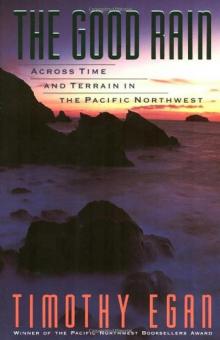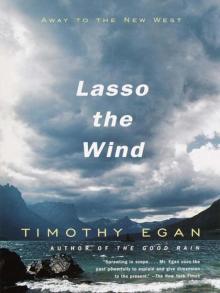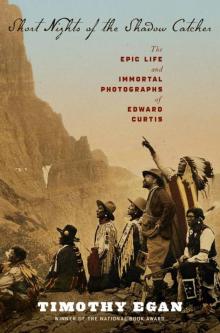- Home
- Timothy Egan
The Good Rain: Across Time & Terrain in the Pacific Northwest Page 17
The Good Rain: Across Time & Terrain in the Pacific Northwest Read online
Page 17
“No! No! No! I want to see a real Indian!”
Driving home from Benjamin’s house, I realized that my perception of the American natives was not all that different from a five-year-old’s. Earlier this summer I had gone looking for the Chief Joseph band of the Nez Perce, but all I’d found was a broken little town in a reservation north of the Grand Coulee Dam. At nine in the morning, I stopped to ask two men for directions to the grave of Chief Joseph, which is the question outsiders almost always ask when they arrive in the arid pine forests of the Colville Reservation in central Washington State. One of the men was clearly drunk; his buddy was on the way. He told me I could drive down to the main junction, where they had a little plaque atop a rockpile in the lot of an abandoned gas station. The inscription said Chief Joseph was buried on this reservation and that he was a military genius who evaded capture for 1,700 miles. But, what about the actual gravesite, I asked. “You can’t see that,” said the second man. Why not? He looked at me coldly, then walked away. Driving through the reservation I saw the worst poverty in the Northwest; homes without electricity or front doors, rusted cars lying in dried streambeds, emaciated animals prowling through backyard garbage.
When I went to the Warm Springs Reservation in Oregon looking for the horse-riders and fishermen of the inland Columbia River, I found a suicide epidemic. Within a two-month period, seven young tribal members had killed themselves. “It’s so hard to stay alive,” said a Paiute boy of eighteen; two of his brothers had hanged themselves. For most of my life, American Indians have existed only as icons, naturalist heroes of the past; I’m like Benjamin.
The people who took over the Northwest did not treat the Indians any better or worse than other Americans had treated other tribes. Winthrop cast a cold eye on the “fishy siwashes,” as he called them. He was disgusted by their inability to contain themselves after drinking alcohol. But in writing that civilization in the Northwest would be different from any other, more attuned to the land and its influences, Winthrop might as well have been talking about the Indians. They were different from others on this continent, and they still are. The Salish-speaking people along the misted coastline, so wealthy in pre-European times, have now used the lawsuit so effectively they have become role models for the rest of the 1.6 million American Indians. Their efforts have led to a renaissance among some tribes. If old trees are saved because the Nisquallies threaten lawsuits against loggers who damage the salmon watershed, we have them to thank. If Puget Sound is kept free of toxic dumping for the same reason, the tribes are a big part of the reason why.
The aboriginal people of the Pacific Northwest never saw anything like the riches that came to the fallen nations of Japan and Germany after World War II. After all the Indian wars and deceptive treaties, the legalized land-grabbing, the allotment schemes and the assaults of state courts, the tiny nations that lived at river mouths draining the Cascade Mountains were left with nothing but the lawsuit.
And so it was that the non-Indian property owners of Tacoma came to offer $162 million for the land that was supposed to belong to the Puyallups for eternity. If the tribe approves the package, it will be one of the largest Indian land claims in history—second, in this century, to the Alaskan native settlement in 1971. The full moon is well over Commencement Bay, flooding the water in silvery light. All the votes are in. Silas Cross, who runs a small smoke shop and has a satellite dish in his backyard and still farms part of the original allotment given his grandfather, says, “They’re asking us to give up something you can never give up. It’s just another Indian buyout.” But Frank Wright, Jr., doesn’t see it that way; after nearly 150 years of passive restraint, the Puyallups can now control their destiny, he says. His father, the tireless Fish War leader, cannot lend his voice; he’s too sick to talk. And Bob Satiacum is back in jail, facing charges in Vancouver of having sex with a minor.
If the offer is approved, the Puyallups will get cash, their own deep-water port on Puget Sound—offering them the opportunity to become the first Native American tribe to control a Pacific port—nine hundred acres of tideland, some forest land, a permanent trust fund, and $10 million to rebuild the fishery in the Puyallup River. The river? Why would the Puyallups want anything to do with a limp channel bordered by industrial parasites and sewage-treatment plants? You can’t breathe life back into a body that’s gone cold. Frank Wright, Jr., looks out from the old brick building, beyond the freeway and the smokestacks, and sees a river that one day will bring salmon back to his people. He has no idea what the Puyallup River used to be like, but his father, his body now atrophied from cancer treatment, has told him stories. Plenty of stories.
The vote is 319 to 162 in favor of accepting the offer and dropping the historical claim to the land. A few days later, Frank Wright, Sr., dies of cancer at the age of fifty-nine. By modern standards for the Puyallups, he was an old man.
Chapter 7
FRIENDS OF THE HIDE
At the Nisqually Delta, where Puget Sound picks up the runoff from one of Mount Rainier’s longest glaciers and then doglegs north, creatures of the air and water have hunkered down for their last stand. It’s an odd place for a sanctuary, this intersection of man and aqua-beast, of freeway and marsh, of fresh water and salt. At the time of Winthrop’s visit, the mouth of the Nisqually served as regional headquarters for the otter- and beaver-hide trade; it was a swap mart for hard-edged men carrying furs to be worn by soft-edged urbanites in distant cities. The fashion designer stood atop the predator chain then.
I come to the Nisqually Delta, not by canoe as did Winthrop, but on an interstate that carries eight lanes of traffic through eighty miles of megalopolis. As the road drops to cross the delta, leaving behind acres of inflatable exurbs and Chuck E. Cheese pizza palaces, the land turns shaggy and damp, a sudden reappearance of the original form. What used to be the fortress of man, surrounded by wild, has become the fortress of beast, surrounded by city. I find a handful of Nisqually Indians holding to a slice of land along the river, and soldiers playing golf on a bluff once guarded by the Hudson’s Bay Company. The mosaic of salt water and river rush—one of the last true wetlands left on the West Coast—now is a federal wildlife refuge, the animal equivalant of the Indian reservation. Hunters pick off returning loons as they near the Nisqually, but once the birds make it through the firing line to land on the fingers of the river, they find a smorgasbord of food, and federal government protection. The refuge designation came just in time: the Weyerhaeuser Company, owner of 1.7 million acres of timberland in Washington, wanted to build a log-export facility in the Nisqually Delta to help speed the shipment of fresh-cut trees to Japan. When the company backed off during the timber recession of the mid-1980s, conservationists stepped in and saved the delta. However, it may turn out to be wildlife under glass; the county surrounding the delta is the fastest-growing community in the country outside of Florida, and Weyerhaeuser, which calls itself the tree-growing company, plans to build a new city of fourteen thousand people on its acreage bordering the refuge.
A sponge for winter rains, and feasting grounds for species that thrive in the blend of mud and grass, the wetlands in this wet land have always been looked upon as ill-defined and malformed. Not suitable for human habitation, they were judged to be worthless. One by one, the estuaries of the West Coast have been filled in, paved over, planked up. Puget Sound, with more than two thousand miles of inland shoreline, has only a few small places left where river and soil and tide converge to support the bounty of delta life. The Snohomish, outside Everett, has lost three-fourths of its marsh; the Duwamish marsh has disappeared altogether, its tideland filled in with 12 million cubic yards to accommodate Seattle’s early-century expansion. Commencement Bay, where the Puyallup has lost all but a few acres of its wetland cushion, is a toxic nightmare, home of the three-eyed fish and a pulp mill which has been the source of one of the most lasting nicknames in the Northwest—the Aroma of Tacoma. For the last century, oxygen-starved marine life in Commenc
ement Bay has been fed a diet of heavy metals, PCBs and algae.
The Nisqually, for the time being, looks as it did when Winthrop saw it: wide and wet, a stew of shorebirds and marine mammals, more than 240 animal species, with tall grass growing around scattered firs, thick cottonwoods along the river, and in early summer, waves of pink blossoms from the thorny blackberry bushes. I could set up camp here, as the Nisquallies have for centuries, as Winthrop did overnight, and never need to walk more than a few miles to find every food source necessary to lead a long life. But I don’t need the delta for food.
Walking a trail planked over the mud and eelgrass on a warm summer morning, a day when much of the country is praying for water and trembling about the prospect of global warming, I pass through a window to the air-conditioned wild; with each step, traffic noise gradually recedes and the full-throated sounds of marsh creatures gain. Inside this thousand-acre garrison eagles nest atop box springs of heavy twigs, mallards feast, needle-legged blue herons and big-headed belted kingfishers dive for prey, and assorted others of webbed toe and water-resistant coat hide out for a few weeks. But where are the sea otters? Winthrop found stacks of their furs inside the palisade of Fort Nisqually here. Where are the packs of wolves that howled outside the gates and disrupted his sleep? Where are the whales he dodged while paddling down the length of Puget Sound? Where are the geoducks he called “large, queer clams,” century-old bivalves with necks half as long as a jumprope?
To find a sea otter in the Northwest in the last years of the twentieth century, you go to the Seattle Aquarium, where a trained mammal does tricks for tourists. Otherwise, the animal that brought white men to this corner of the world has largely disappeared—officially extinct off the Washington, Oregon and British Columbian coasts for nearly half a century. A few transplants introduced under the protection of federal laws have since been placed in Northwestern waters, but their fate is uncertain. A recent spill from a barge carrying heavy bunker oil killed several of them; with their fur soiled, sea otters lose their coat of warmth and die a painful death from hypothermia. Otter Crest, on the Oregon coast, has no such creatures swimming near its beach. Nootka Sound, where Captain Cook first noted the easy-kill, big-money mammal, has no descendants from that era playing in its waters.
Sea otters have never caused great fear or awe. They backstroke through cold channels looking for new places to make water slides. They plunge to great depths, seeing how long they can hold their breath. They sing to their young, which gave rise to the myth of the mermaid; horny sailors, hearing the distant song of a sea otter mother to her pup, imagined a large-breasted amphibian calling them to shore. Few things are funnier to one otter than sneaking up on another otter and biting the mate’s tiny ear. They never migrate, food is easy, the water’s always fine.
To be a comedian in nature is to have a short life. While the pursuit of spice and the cultivation of tobacco may have led to early colonization of the eastern part of North America, it was this mammal, among the most docile in all of nature, that was responsible for bringing the hordes of Boston and King George men to the Pacific Northwest. Once otter pelts replaced the nonexistent Northwest Passage as the only justification for sailing eight months around Cape Horn and up the Pacific Coast, it took less than half a century to kill most of them. By the 1820s, up to 500,000 otters had been caught and stripped of their thick, luxuriant hide. Thus began a pattern: as long as this land brought wealth to those who stepped ashore, it was prized. Winthrop, and others who said the lasting value of the Northwest was not extractive, were lonely voices until the time came when there was very little left to take.
Peter Pans at heart, sea otters shy away from early attachment; when at last they do breed, the females seldom produce more than a single pup. A standard ploy during the early nineteenth century was to snatch the baby, thus luring the mother out, who was then clubbed. The orphan, more often than not, died without the mother’s milk or drowned without the benefit of maternal swimming lessons, accelerating the decline of the species. But through it all the otters kept on their backs, balancing clams on their noses, playing pinch with Dungeness crabs. A large sea otter pelt, in perfect condition, could fetch as much as two thousand dollars in London during the early nineteenth century. Such money—one pelt could bring the equivalent of five years of wages and a stake in the bank—was earned from the simple task of slamming the skull of a smiling eighty-pound mammal. By the early 1820s the Hudson’s Bay Company was calling for conservation measures. Their network of trading posts, so English and orderly, so profitable and legally monopolistic, was in danger of losing its chief source of income. But by then it was too late.
Asked to assess the value of all land north of the Columbia River before the United States and England settled their boundary dispute, an American government expert wrote that “The country north and west of the Columbia, extending north to the 49th degree of latitude and west to the sea, is extremely worthless.” A marsh, thick with marine life, had no value. A mountain range with glaciers and streams and spires enough to fill an area twice the size of the Swiss Alps, was dispensable. A dozen rivers, each carrying enough salmon in a single run to feed every native and every Boston man in the new country at a single sitting, was a trifle. The great problem with the area north of the Columbia was, as the American wrote, “There are hardly any furs.” Having depleted the Northwest of the first resource to be exploited here, the Boston men were already pronouncing it worthless.
Young Teddy Winthrop and three Clallam Indians arrived at the Nisqually Delta on a hot day in late August of 1853. Seattle, fifty miles to the north, was a mudflat with a handful of timber beasts and a waterfront whorehouse. Olympia, one inlet west of the delta, housed a few rotting territorial-government structures. But the Hudson’s Bay Company post at Nisqually, situated on land that had recently become American territory, exuded an air of permanence and authority. When Winthrop pulled up his canoe at the river’s mouth and hiked inland to Fort Nisqually, the company was already turning to agriculture, growing strawberries, gooseberries, carrots, potatoes and other vegetables in such quantities that they kept the other forts supplied with food and sold the surplus to the Russians in Alaska. Winthrop, gazing up at the twilight-pink flank of Rainier behind the ten-foot-high walls of the fort, found the setting enchanting. He wanted to get closer to this “giant mountain dome of snow swelling and seeming to fill the aerial spheres.” The Nisqually Glacier, one of the longest tongues of ice on the mountain and the river’s headwaters, gleamed in late sunlight. A climate barometer, the glacier has shrunk by more than a mile since then.
The fort was full of the commerce of dead-animal dealings.
Winthrop wrote: “Rusty Indians, in all degrees of froziness [sic] of person and costume, were trading at the shop for the three b’s of Indian desire—blankets, beads, and ’baccy—representatives of need, vanity and luxury.” He noted a great quantity of “otter, beaver and skunk skins and similar treasures.” Winthrop again enjoyed the civil company, imported wines and fine china of the Gentlemen running the company post. He obtained two horses for the trip across the mountains, another guide, this a Klickitat Indian from east of the Cascades, more hardtack and pork, some roots. The shopping spree cost him thirty dollars. Bedding down inside the fort at night, he heard the howl of timber wolves. Lucky man. The true call of the wild has not been heard in this part of the world for some time. The poison campaign which killed upwards of two million wolves in less than fifty years was already underway in the midnineteenth century. Even the Gentlemen of the Hudson’s Bay post at the Nisqually Delta, who showed some conservationist leanings despite the nature of their business, took up one of the favorite weapons of the frontier—strychnine—against the wolves that attacked their livestock.
To find a wolf in the Northwest in the last years of the twentieth century, you must go above the Nisqually Delta to the bluff and travel south for about thirty miles until you reach a somewhat spooky warren of orange-eyed carnivores—
Wolf Haven, it’s called. The Gray Wolf Valley on the Olympic Peninsula has no such creatures. Bounty hunters killed off the last wolves in the state fifty years ago in that valley, which is one big reason why helicopters are chasing goats in the Olympics this summer, trying to thin a herd that no longer has a predator.
At Wolf Haven, everybody has a beard. People who stay together long enough are supposed to start looking alike; a similar trend is evident at Wolf Haven, where peacocks perch from the misted branches of spruce trees, and the evening air is filled with the jabbering of humans trying to communicate with three dozen wolves. Two volunteers proudly show me their bite marks. One of them says, “There is no better feeling in the world than French-kissing a wolf.”
On summer nights when the sky is clear and the great black Out There is full of mystery, cars drive along the old Hudson’s Bay Company fur-trading trail, turn off into the woods and pull up at Wolf Haven. Here, the people take pictures and then gather around a big bonfire and howl. A whole gaggle of captive wolves howls back. And then the Wolf Haven leaders try to get everybody to howl together. A “howl-in,” they call it. It’s all part of the job of trying to remake the image of one of the most maligned creatures in history.
I walk among the wolves with their benefactor, a chain-smoking thirty-six-year-old man named Stephen Kuntz. He has a beard, a bit of a beer gut, a baseball hat with a wolf emblem on the front. His van carries a personalized license plate—WOLF 1. He stops to chat with Windsong, a female buffalo wolf who spends a lot of time on the rubber-chicken circuit, appearing before Rotary Clubs, at county fairs, in an occasional spot on the Today show. Nearby is a timber wolf named Rogue, retrieved from the garbage dumps of Portland, now learning to howl for the first time. The star of this sixty-acre spread is a white arctic wolf named Lucan. This ghost-colored carnivore was once an habitué of a rich man’s private zoo; upon his death, the owner left Lucan with Wolf Haven.

 The Immortal Irishman
The Immortal Irishman The Worst Hard Time: The Untold Story of Those Who Survived the Great American Dust Bowl
The Worst Hard Time: The Untold Story of Those Who Survived the Great American Dust Bowl The Good Rain: Across Time & Terrain in the Pacific Northwest
The Good Rain: Across Time & Terrain in the Pacific Northwest Breaking Blue
Breaking Blue Lasso the Wind: Away to the New West
Lasso the Wind: Away to the New West The Big Burn: Teddy Roosevelt and the Fire That Saved America
The Big Burn: Teddy Roosevelt and the Fire That Saved America Short Nights of the Shadow Catcher
Short Nights of the Shadow Catcher A Pilgrimage to Eternity
A Pilgrimage to Eternity The Worst Hard Time
The Worst Hard Time The Big Burn
The Big Burn